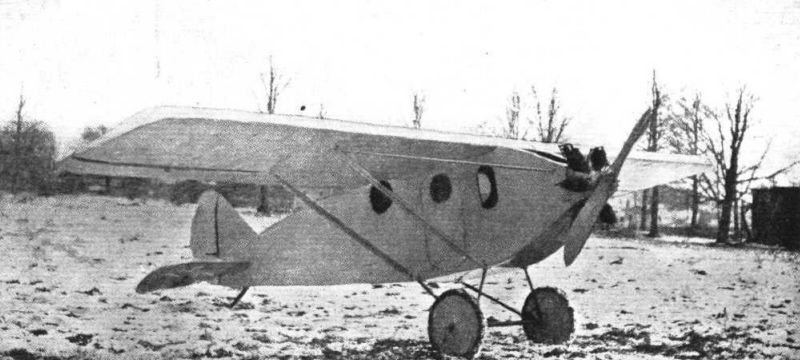
Описание
Страна : США
Год : 1925
Единственный экземпляр
Flight, March 1927
THE MCCARTHY AIR SCOUT
An American Two-Seater Enclosed Light 'Plane
WE give a brief description, together with illustrations, this week of a somewhat novel American commercial aeroplane, which may be classed as a light 'plane - the McCarthy Air Scout. This machine, the first product of the McCarthy Aeronautical Engineering Co. of Detroit, is a "semi-cantilever" monoplane with a very deep fuselage, forming a totally enclosed cabin for pilot and passenger. It is powered with a 45 h.p. Anzani engine which, it is claimed, provides ample reserve of power for all conditions of flying.
The Air Scout was designed for light commercial work or sporting purposes. It is strongly constructed, safe and easy to fly, and can be cheaply operated. The wings, which are of fairly thick section (revised Martin) are in two units, each composed of two large main spars constructed of spruce strips planked with three-ply birch. The ribs - 13 to each wing - are constructed of channeled spruce members with three-ply birch capstrips, all joints being glued and screwed (no nails being used). The trailing edge is formed by cable.
Each wing is securely attached to the top of the fuselage by two large steel bolts from the inside, and braced by three steel tubes, streamlined with Balsa wood, two from the lower longerons of the fuselage taking the lift, and the third from the nose of the fuselage, being bolted direct to the engine plate.
At the root of each wing is a 5-gal. petrol tank, with a filler opening through the upper surface and two outlets, one in each end of the tank, which supply a constant feed to the engine at all flying angles. Both wings may be completely removed by two men in half an hour.
The fuselage is 16 ft. long, 4 ft. deep and 2 ft. wide, and is constructed of four laminated ash and spruce longerons, and eight spruce bulkheads, securely tied with three-ply birch gusset plates, glued and secured in position with screws. At first the covering of the fuselage consisted of vulcanised fibre, shrunk on and fastened with brads and glue. Now, however, the covering is three-ply birch, similarly attached, resulting in a much more rigid construction.
The forward portion of the fuselage forms an unobstructed cabin, 7 ft. long, accommodating the pilot and passenger, the seats being arranged in tandem with the passenger's seat forward. There is only one set of controls, in front of the pilot's seat and allowing a clear entrance to the cabin through the door in the starboard wall of the latter. There are seven windows in the cabin, one forward in the roof and three in each side wall, the two rear windows at the side of the pilot being open and all the others being "glazed" with celluloid. In the upper part of the cabin, forward of the passenger, is the instrument board, which is in full view of both pilot and passenger.
The landing gear is of the conventional type, consisting of two steel tube Vees and a straight-through steel tube axle, cable braced. The struts are streamlined with balsa wood, and the wheels are of the wire type, with fabric covering. The axle is secured by 1/2-in. rubber cord, and the Vee connections to the fuselage are pin type. The tail skid is of laminated ash leaves, secured at the top end, with a steel shoe on the lower leaf.
Both the horizontal and the vertical stabilising surfaces are of extremely thick section, and are built integral with the fuselage, whilst the elevators and rudder, to which respectively they are hinged, are also of thick section, but are unbalanced. The control surfaces arc built up of spruce and plywood spars, with ribs of channeled spruce and three-ply birch capstrips; the trailing edges are cable.
The controls are of the cable and pulley type, with streamlined steel horns. The usual rudder bar has been replaced by an equaliser under the pilot's seat and two pedals. The aileron control wires operate within the wings.
The power plant is an Anzani 6-cyl. engine, rated at 45 h.p. at 1,450 r.p.m. It is mounted on a steel plate securely fastened to a 1 in. laminated birch bulkhead by twenty 1/4-m. steel bolts. The engine is covered on the two sides by small aluminium cowlings. The carburettor, which is mounted directly on the bottom of the engine, is outside the fuselage, and is fed by gravity from the tanks in the wings. Magneto and oil pump are located inside the fuselage, where they are protected from moisture, etc. A three-ply birch-panelled bulkhead separates the oil tank, oil pump, and magneto from the cabin.
The main characteristics of the McCarthy Air Scout are :-
Span 26 ft. 0 ins.
Overall length 19 ft. 10 in
Height 6 ft. 9 in.
Chord 5 ft. 3 in.
Wing area 136-5 sq. ft
Angle of incidence 3°
Area of ailerons 18 sq. ft.
Area of elevators 9 sq. ft.
Area of horizontal stabilizer 13 sq. ft.
Area of fin 2-25 sq. ft.
Area of rudder 6-15 sq. ft.
Weight empty 560 lbs.
Weight laden 1,020 lbs.
Wing loading 7-5 lbs./sq
Power loading 22 lbs./h.p
Fuel capacity 10 galls.
Speed range (full load) 40-120 m.p.h
Radius 300 miles.
- Flight, March 1927
THE MCCARTHY AIR SCOUT
Фотографии
-
Flight 1927-03 / Flight
THE MCCARTHY AIR SCOUT: An American light commercial monoplane, fitted with a 45 h.p. Anzani engine.
-
Flight 1927-03 / Flight
THE MCCARTHY AIR SCOUT: Three-quarter rear view showing the door leading to the totally-enclosed cabin.
- Фотографии

